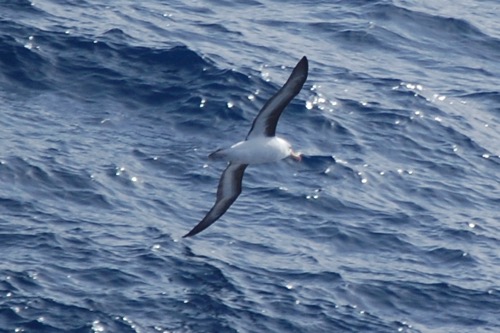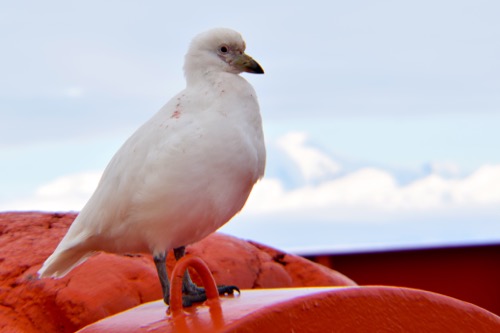Travel Update
This morning at approximately 0800, we entered the Strait of Magellan. Our first trip through the strait (back in early September) occurred overnight. I was tucked away in my bunk and unable to see the sights due to the lack of light. Today, we entered the strait in bright sunshine and high winds. We will travel a few hours through the mouth of the strait before entering the pilot embarcation area. A Chilean pilot will board the RVIB Palmer to assist in the navigation of the shallow waters of the Strait of Magellan. Prior to leaving for my trip, I was told to be sure and watch the pilot board the ship. In September, the pilot boarded around 0200. I'll admit, I was asleep for that early morning transfer. Due to our glider detour, our entrance to the strait and the pilot pick-up will happen during the daylight hours. The estimate for the pilot's arrival is 1600.
TGIWF
Today marks the last 'Thank Goodness It's Wildlife Friday'. In the past, I have focused on highlighting the species that are found in the waters and on the shores of Antarctica. As we continue to make our way towards Punta Arenas, Chile, I thought I should highlight species that are common to the areas traveled in the past few days.
Commerson's Dolphins (Cephalorhynchus commersonii)
This dolphin species is a common sight in the coastal areas of southern Argentina and the Strait of Magellan. These dolphins were first described by a French physician and botanist named Philibert Commerson in 1767. These small dolphins reach lengths of 5 feet and weight 190 pounds, on average. The Commerson's dolphin has some very distinct physical features that set it apart from many other species in the area:
- Unique color pattern (white body with black head, forward flippers, dorsal fin and tail)
- Girth as much as two-thirds of its body length (rotund)
- Conical head with no noticeable beak
- Rounded flippers (left flipper is sometimes serrated on the anterior tip)
- Rounded dorsal (back) fin


These dolphins eat a variety of prey including small fish, mysid shrimp and other invertebrates. These dolphins have the ability to reach swimming speeds in excess of 10mph and use this speed when foraging for food. They are generally found in small groups, but may congregate in larger groups in some of the shallower waters of the strait.
Albatross (family Diomedeidae)
The albatross are a group of large seabirds that are generally found in open ocean, far from land. Albatross are common in the Southern Ocean and north Pacific Ocean, but are generally not found in the north Atlantic Ocean. There are a number of large birds in the Southern Ocean like the northern giant petrel (Macronectes halli) and the brown skua (Catharacta lonnbergi). Albatrosses, however, are the largest of the flying birds with wingspans reaching a maximum length of 12 feet, in some species. The most commonly accepted number of species of albatross is twenty-one. Albatross, like their petrel 'cousins', use enlarged nasal glands to remove excess salt. Albatross are known for their ability to travel long distances. They use two different, highly efficient soaring techniques in order to travel upwards of 1000km (~620miles) per day.


Many albatross are in decline due to certain types of fishing techniques and pollution. An international agreement called the Agreement on the Conservation of Albatross and Petrels (ACAP) includes 13 countries working to limit harm and death to these birds. To find out more about ACAP and seabird conservation, visit the ACAP website or the Audubon Advocacy page on the ACAP
Wildlife Round-Up
The following list represents wildlife seen as of 10/14/16. These sightings are based on my personal experience as well as sighting information from others aboard the ship.
Birds
- Kelp gull (Larus dominicanus)
- Sooty shearwater (Puffinus griseus)
- Southern Giant-petrel (Macronectes giganteus)
- Wandering albatross (Diomeea exulans)
- Black-browed albatross (Thalassacrche melanophrys)
- Great Shearwater (Puffinus gravis)
- Cape petrel (Daption capense)
- Antarctic petrel (Thalassoica antarctica)
- Snow petrel (Pagodroma nivea)
- Brown skua (Catharacta lonnbergi)
- South polar skua (Catharacta maccormicki)
- Antarctic shag (Phalacrocorax bransfieldensis)
- Snowy sheathbill (Chionis albus)
- Gentoo penguin (Pygoscelis papua)
- Adelie penguin (Pygoscelis adeliae)
- Emperor penguin (Aptenodytes forsteri)
- Magellenic penguin (spheniscus magellanicus)

Mammals
- Humpback whale (Megaptera novaeangliae)
- Antarctic minke whale (Balaenoptera bonaerensis)
- Killer whale (Orcinus orca)
- Commerson's dolphin (Cephalorhynchus commersonii)
- Leopard seal (Hydrurga leptonyx)
- Weddell seal (Leptonychotes weddellii)
- Crabeater seal (Lobodon carcinophaga)
- Antarctic fur seal (Arctocephlus gazella)



Comments